
This article was originally published by the HVAC School; it has been slightly edited. It is the second in a three-part series.
In Part 1 of this series, I outlined the basic understanding of Zonal Pressure Diagnostics (ZPD)—what it means and what it does. Most importantly, I showed how an effort to simplify a fairly complex testing procedure turned it into a wildly inaccurate part of testing in the building performance industry.
In this second part, I will establish a logical starting point for the ZPD testing process and dig a little deeper into its core.
In Part 1, I identified ZPD as primarily the process of diagnosing/estimating how much of the total air leakage for an envelope comes from any given attached or intermediate zone (i.e., attics, crawlspaces, garages, or basements). An attached but unconditioned utility room is another example of such a zone.
Therefore, in addition to possibly leaky windows and poor seals on exterior doors in a conditioned room, when we test how much this room is connected to outside, we are essentially testing how much the attic/crawlspace/garage is connected to the room.
The first logical step to take is to quantify the connection between the envelope and the attached or intermediate zones.
Before diving into this, it’s important to first understand that with the blower door maintaining the house at -50 Pa, zone pressure measurements indicate a ratio of the cumulative size of the leaks between said zone and the house relative to the cumulative size of the leaks between the zone and outdoors.
In the not-so-distant past, when I first started getting into ZPD, I would test homes with the blower door running. I’d check the connection between the house and the attic, for example, and I would often find readings like these:
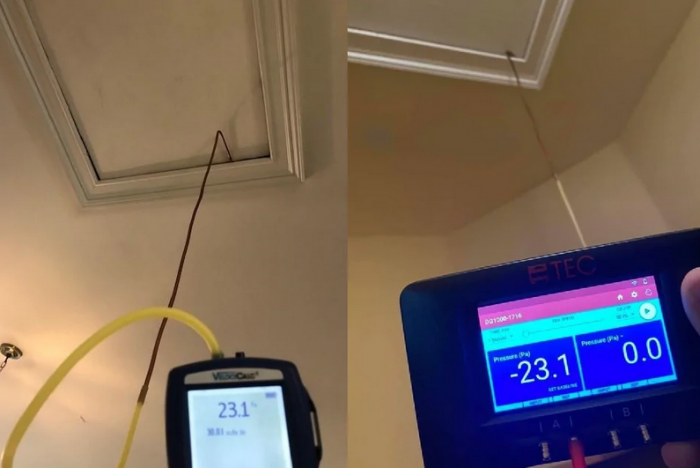
The only two details these two homes have in common are that they both have a well-vented attic and are both very leaky. The one on the left is from an 1800-sq.-ft. envelope with a 2600 CFM50 blower door number or 1.45 Leakage Area Infiltration Ratio (LAIR). The one on the right is from a 3100-sq.-ft. home with a 5177 CFM50 blower door number or 1.67 LAIR.
By looking at these, you might think, “Well, that attic must not be well vented.” But that’s not how ZPD works.
The ZPD readings from these well-vented attics were so low because the ceiling plane in these two cases is extremely leaky. That, in turn, is a large contributor to the total home leakage. It explains why the envelope leakage rate is so high on both.
As a side note, attic or crawlspace ventilation is pretty straightforward:
- Are there vents along the roof overhang soffits?
- Are there vents along the side of the house?
- Can you see light if you go into any of them?
- Can you feel air movement across these vents? (This last one is largely dependent on indoor vs. outdoor temperature differential, as stack effect is its driving force. Wind matters a great deal, too.)
In addition to that, vented attics and crawlspaces have a lot less volume than the living space with which they share floor area. Therefore, it doesn’t take an obscene amount of ventilation to be considered properly vented.
Back to ZPD
Remember from Part 1: “In cases where air must pass through at least two barriers to leak into or out of a house, ZPD is a way to use measured pressures to infer the location and size of air leakage paths.” This snippet is from the Zone Pressure Diagnostics Trainer manual, which is available from The Energy Conservatory.
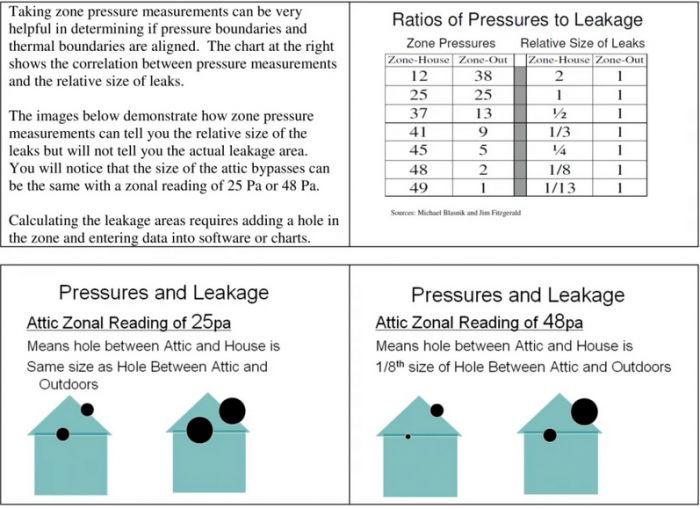
Suppose we’re testing a house for leakage with the blower door running, keeping the house at -50 Pa. If we then proceed to do ZPD testing and get a reading of 25 Pa for an attached zone (attic/crawlspace/garage), that means that the cumulative size of all the leaks between the house and the zone is the same cumulative size of all the leaks between the zone and outside.
Think of it this way:
If this zone were a vented attic with 1 sq. ft. of ventilation area between it and outside, there would be 1 sq. ft. worth of infiltration area between the attic and the living space.
By the same token, if the zone were a vented attic with 10 sq. ft. worth of ventilation area between it and outside, there would be 10 sq. ft. worth of infiltration area between the attic and the living space. As you can imagine, that’s a nightmare from a temperature and humidity control standpoint.

Suppose, on the other hand, the ZPD pressure reading was 45 Pa. Then, according to the table above, the size of the infiltration area between the zone and the house would be 1/4 of the ventilation area between the zone and outdoors.
If you have a vented attic with a ZPD reading of 45 Pa and 50 sq. ft. worth of ventilation area, then you’d have more leakage area (50 x 0.25 = 12.5) than if you had an attic with a 25 Pa ZPD reading and 10 sq. ft. worth of ventilation area (10 x 1 = 10).
Think of ZPD as % of relative humidity. Air at 75° DB and 50% RH contains less moisture than air at 100° DB and 30% humidity. It is the same concept. The ratio of the size of one opening (zone to house) is relative to another (zone to outdoors).
Here are some photo examples of ZPD readings with different pressure ratios between the zones and the envelope:
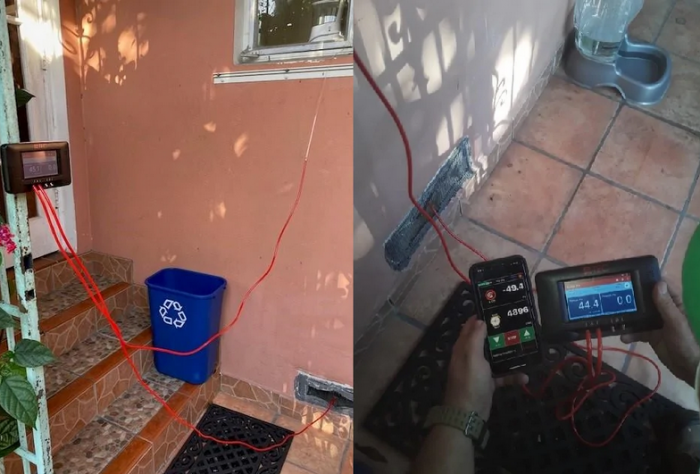
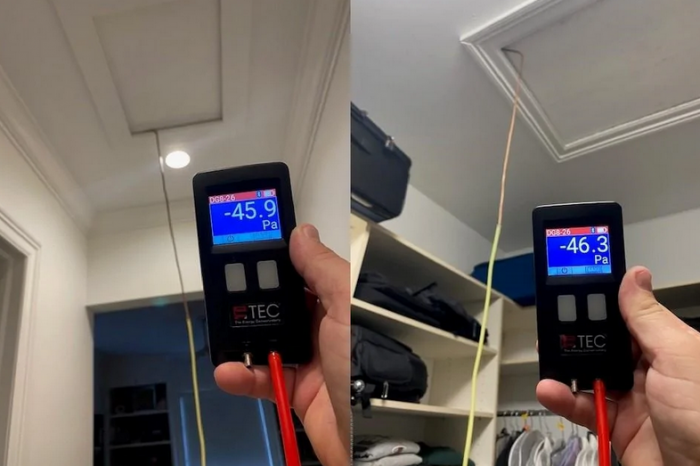
With varying degrees of ventilation strategies and net-free area for intentionally vented attached zones, establishing the pressure ratio’s relationship between the zones and the envelope is the first logical step in the ZPD process. Again, these zones are the attic/crawlspace/basement/garage, not little Johnny’s room that gets hot at night when he closes the door.
Stay tuned for the third and final post in this series, when I will get into how to translate these pressure ratio readings into actual leakage expressed in CFM50.
_________________________________________________________________________
Genry Garcia is president of Comfort Dynamics, Inc., a full-service heating, ventilation, and air conditioning mechanical and building control contractor based in Miami, Florida. Images courtesy of the author.
Weekly Newsletter
Get building science and energy efficiency advice, plus special offers, in your inbox.




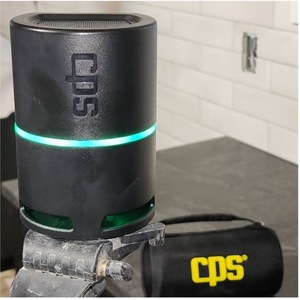


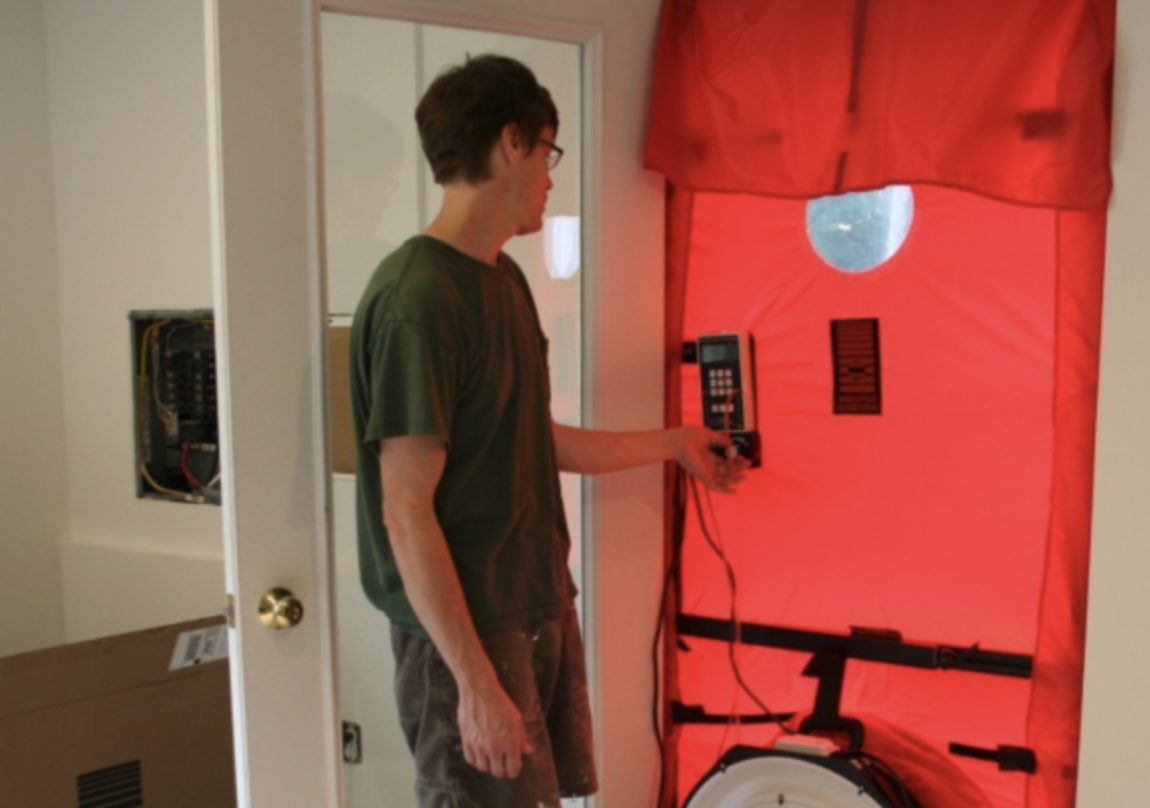






0 Comments
Log in or create an account to post a comment.
Sign up Log in